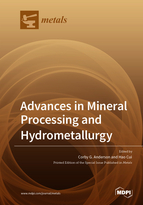Advances in Mineral Processing and Hydrometallurgy
A special issue of Metals (ISSN 2075-4701). This special issue belongs to the section "Extractive Metallurgy".
Deadline for manuscript submissions: closed (31 May 2020) | Viewed by 136589
Special Issue Editors
Interests: extractive metallurgy; mineral processing; waste minimization; recycling
Special Issues, Collections and Topics in MDPI journals
Interests: extractive metallurgy; mineral processing; waste minimization and recycling
Special Issues, Collections and Topics in MDPI journals
Special Issue Information
Dear Colleagues,
Please consider submitting some of your excellent work in a Special Issue of Metals devoted to aspects of Mineral Processing and Hydrometallurgy. This also includes Characterization along with Recycling and Waste Minimization. Possible topics include Mineralogy, Geometallurgy, Thermodynamics, Kinetics, Comminution, Classification, Physical Separations, Liquid Solid Separations, Leaching, Solvent Extraction, Ion Exchange, Activated Carbon, Precipitation, Reduction, Process Economics and Process Control. Suggested application areas are in Gold, Silver, PGM’s, Aluminum, Copper, Zinc, Lead, Nickel, and Titanium. Critical Metals articles on topics such as Lithium, Antimony Tellurium, Gallium, Germanium, Cobalt, Graphite, Indium, and the Rare Earths are also welcomed. Again, both primary and recycled aspects will be considered. Thank you.
Prof. Dr. Corby G. Anderson
Dr. Hao Cui
Guest Editors
Manuscript Submission Information
Manuscripts should be submitted online at www.mdpi.com by registering and logging in to this website. Once you are registered, click here to go to the submission form. Manuscripts can be submitted until the deadline. All submissions that pass pre-check are peer-reviewed. Accepted papers will be published continuously in the journal (as soon as accepted) and will be listed together on the special issue website. Research articles, review articles as well as short communications are invited. For planned papers, a title and short abstract (about 100 words) can be sent to the Editorial Office for announcement on this website.
Submitted manuscripts should not have been published previously, nor be under consideration for publication elsewhere (except conference proceedings papers). All manuscripts are thoroughly refereed through a single-blind peer-review process. A guide for authors and other relevant information for submission of manuscripts is available on the Instructions for Authors page. Metals is an international peer-reviewed open access monthly journal published by MDPI.
Please visit the Instructions for Authors page before submitting a manuscript. The Article Processing Charge (APC) for publication in this open access journal is 2600 CHF (Swiss Francs). Submitted papers should be well formatted and use good English. Authors may use MDPI's English editing service prior to publication or during author revisions.
Keywords
- Characterization
- Economics
- Comminution
- Classification
- Separations
- Recycling
- Leaching
- Concentration
- Precipitation
- Reduction
- Waste minimization
Related Special Issue
- Advances in Mineral Processing and Hydrometallurgy II in Metals (8 articles)







